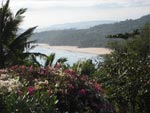Sumba – an island living in the past
Sumba is one of the few islands in Indonesia where a majority of the population still follow the ways of their ancestors. One gets the sense that time has passed this island by and that only now it is slowly being drawn into the present. On Sumba faith in the old traditions are very strong. Throughout the year the island is the site of many fascinating rituals, the most spectacular of them all are the Pasola ceremonies that take place during the months of February and March at select locations along the west coast of the island.
The Pasola’s are wild and martial events involving hundreds of charging horsemen battling with spears on a large playing field. Serious injuries are common and there are occasional deaths of horses and even riders. In fact a Pasola is not considered successful without a proper amount of bloodletting. In Sumba blood on the ground is necessary to make it fertile, and one of the aims of the Pasola is to make the conditions right for the rice harvests that take place in the months of April and May.
The main aim of the traditional Sumbanese religion is to maintain a peaceful and fruitful relationship with the Marapu, the ancestral spirits. To do so there are many Animist rules that must be adhered to in the form of ritual celebrations that are meant to provide the ancestor spirits with food and wealth in the afterlife. In exchange it is expected that the ancestors will bestow increased fertility and prosperity on the living.
The funerary rituals of Sumba continue to this day. Huge blocks of stone are cut and dragged great distances to the mortuary ground to construct mausoleums for the rich and the nobility. An average sized stone can weigh in the range of six tons, and larger stones weigh more than twenty. Until recently, particularly at the funerals of noblemen, literally hundreds of water buffalo, horses, pigs and dogs were slaughtered to accompany the departed soul to the afterlife. The number of animals dispatched was, and still is, prestige enhancing. In Sumba, where the remains of a highly stratified society of nobles, commoners and indentured slavery still exist, it was not uncommon for a family to bankrupt itself to put on a good funeral show. With occasional success, the government is trying to discourage this practice by limiting the amount of slaughtered animals to five.
The social structure of Sumba is organized around the traditional ancestral house and the patrilineal group that claims decent from it. Ancestral houses are the bridge between the visible and invisible worlds and must be perpetuated over time as ritual centers. The ancestral villages are usually built on a defensive height and surrounded by a perimeter wall of stone or a thick cactus hedge. Traditional houses with high peaked roofs are aligned in rows around an open space that contains rectangular stone graves. Some villages, those that fielded war expeditions, kept a “skull tree” on which the human heads of the enemy victims were hung. The Sumbanese were feared head hunters and “officially” abandoned the practice in the 1950’s. However as recently as the late nineties heads were still being taken during major inter clan battles.
The Sumbanese are proud of their culture. They value their traditional way of life and their tribal unity. For foreigners to witness this culture is like looking through a window to the past. In this fast modernizing world it is unfortunate that few places like Sumba remain.





